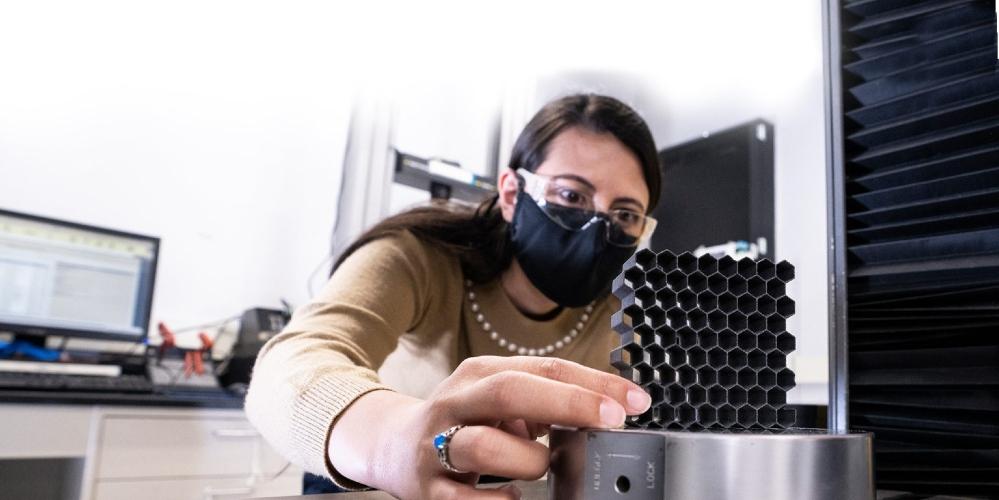- FMA
- The Fabricator
- FABTECH
- Canadian Metalworking
Our Publications
Categories
- Additive Manufacturing
- Aluminum Welding
- Arc Welding
- Assembly and Joining
- Automation and Robotics
- Bending and Forming
- Consumables
- Cutting and Weld Prep
- Electric Vehicles
- En Español
- Finishing
- Hydroforming
- Laser Cutting
- Laser Welding
- Machining
- Manufacturing Software
- Materials Handling
- Metals/Materials
- Oxyfuel Cutting
- Plasma Cutting
- Power Tools
- Punching and Other Holemaking
- Roll Forming
- Safety
- Sawing
- Shearing
- Shop Management
- Testing and Measuring
- Tube and Pipe Fabrication
- Tube and Pipe Production
- Waterjet Cutting
Industry Directory
Webcasts
Podcasts
FAB 40
Advertise
Subscribe
Account Login
Search
Northrop Grumman: parts 3D-printed from ESD PEKK ‘make aircraft cheaper, lighter, and faster to build’
- July 2, 2021
- News Release
- Additive Manufacturing

Additive manufacturing allows parts-makers to take advantage of advanced materials. Images: Northrop Grumman
Following is an edited article posted to the Northrop Grumman website. Titled “ESD PEKK: The Additive Acronym of Advanced Aerospace Manufacturing,” the author is Doug Bonderud.
Higher. Further. Faster. This is the cognitive drumbeat of aerospace innovation, embodied as the quest to find new and better ways of breaking Earth’s bonds, taking to the skies, and even exploring the stars.
Process tends to be the priority for paradigm shifts—such as the move to robotic assembly architectures and data-driven stress testing. But the evolution of additive manufacturing (AM), also known as 3D printing, has opened a new door for discovery: advanced materials.
One such additive advantage comes from electrostatic dissipative polyetherketoneketone (ESD PEKK), which, according to Northrop Grumman fellow Eric Barnes, “makes aircraft cheaper, lighter, and faster to build.”
But how does this high-performance thermoplastic work? What benefits does it offer? And what does it mean for the future of aerospace manufacturing frameworks?
Solving the Static Quo
Static is a serious problem for aircraft. Just as static electricity can build up when you rub a balloon on your hair or scuff your socks along a rug, so too can static charge quickly accumulate in critical craft controls. Without an easy discharge path, it can cause significant damage—or even system failure.
ESD PEKK helps solve this problem through the use of discontinuous carbon fibers. In practice, this means adding carbon fiber to an AM powdered material, which is then placed in a vat and melted by lasers at precise locations, layer by layer. This creates a natural outlet for static discharge in environmental and other aerospace systems. What’s more, the distribution of carbon throughout the material means that no matter the system and no matter its location, it’s protected by a discontinuous defense.
Delivering Dynamic Performance
While shaking off shocks is a significant benefit of this advanced aerospace manufacturing material, that’s not its only advantage.
“One of the benefits, as compared to other high-performance thermoplastics, is it’s relatively easy to process,” noted Barnes. “It brings a lot of really good performance properties to our applications.” In addition, ESD PEKK meets key requirements set out by the FAA for building crewed aircraft, including:
• Improved thermal stability. Even when facing extreme temperature increases or sudden changes, this thermoplastic remains stable, making it ideal for high-stress atmosphere applications.
• Enhanced chemical resistance. Many polymer-based materials are compromised by chemical solvents and liquids; ESD PEKK offers substantively improved resistance to chemical corrosion.
• Reduced radiation damage. For most polymers, space-borne gamma radiation causes structural breakdown, but this new material is minimally affected by radioactive exposure.
• No outgassing. Outgassing is a significant problem in space. “When you put material in a vacuum in space, especially polymers, some of the molecules can come off and float around,” said Barnes. “Eventually, they attach to something and create a film. Over time, this film poses both functional issues for the craft and survivability problems for the crew, especially in confined spaces. However, this advanced thermoplastic produces no outgassing in a vacuum environment, making it safe for spacecraft manufacturing.
Barnes makes the benefits of ESD PEKK clear: “It survived unique space environments with gamma radiation, outgassing, and thermal cycling requirements that most polymers do not meet.”
- Podcasting
- Podcast:
- The Fabricator Podcast
- Published:
- 04/16/2024
- Running Time:
- 63:29
In this episode of The Fabricator Podcast, Caleb Chamberlain, co-founder and CEO of OSH Cut, discusses his company’s...
- Trending Articles
- Industry Events
16th Annual Safety Conference
- April 30 - May 1, 2024
- Elgin,
Pipe and Tube Conference
- May 21 - 22, 2024
- Omaha, NE
World-Class Roll Forming Workshop
- June 5 - 6, 2024
- Louisville, KY
Advanced Laser Application Workshop
- June 25 - 27, 2024
- Novi, MI

























